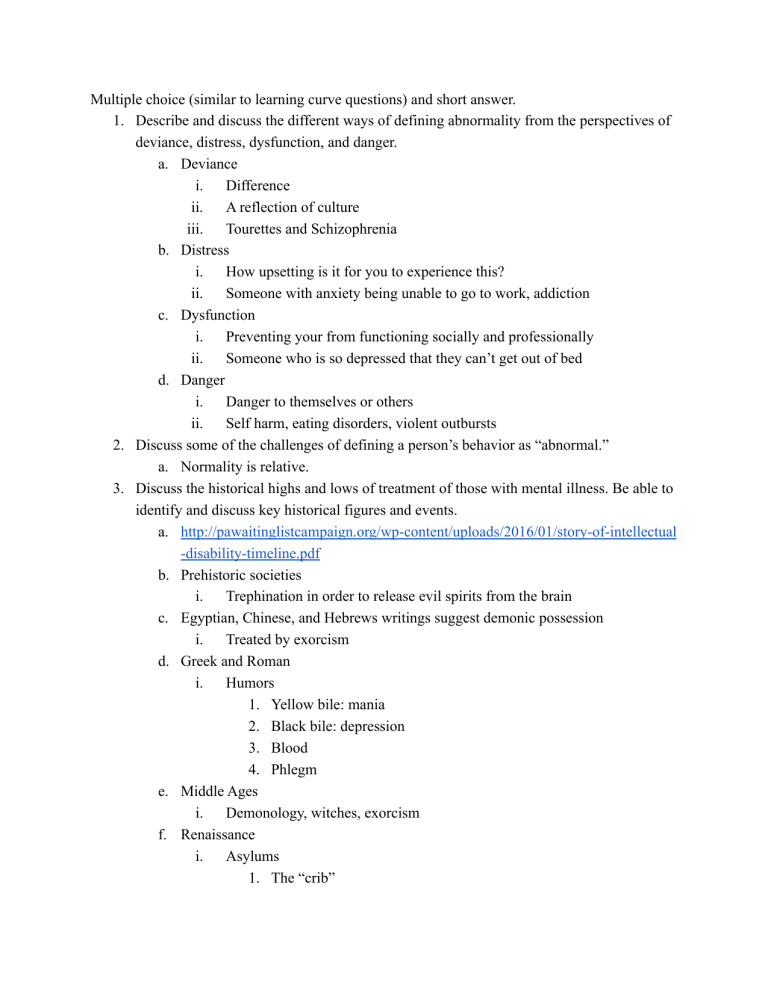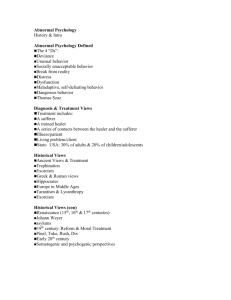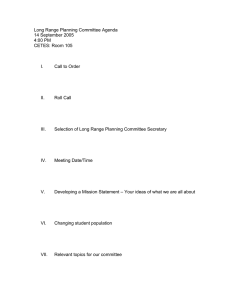
Multiple choice (similar to learning curve questions) and short answer. 1. Describe and discuss the different ways of defining abnormality from the perspectives of deviance, distress, dysfunction, and danger. a. Deviance i. Difference ii. A reflection of culture iii. Tourettes and Schizophrenia b. Distress i. How upsetting is it for you to experience this? ii. Someone with anxiety being unable to go to work, addiction c. Dysfunction i. Preventing your from functioning socially and professionally ii. Someone who is so depressed that they can’t get out of bed d. Danger i. Danger to themselves or others ii. Self harm, eating disorders, violent outbursts 2. Discuss some of the challenges of defining a person’s behavior as “abnormal.” a. Normality is relative. 3. Discuss the historical highs and lows of treatment of those with mental illness. Be able to identify and discuss key historical figures and events. a. http://pawaitinglistcampaign.org/wp-content/uploads/2016/01/story-of-intellectual -disability-timeline.pdf b. Prehistoric societies i. Trephination in order to release evil spirits from the brain c. Egyptian, Chinese, and Hebrews writings suggest demonic possession i. Treated by exorcism d. Greek and Roman i. Humors 1. Yellow bile: mania 2. Black bile: depression 3. Blood 4. Phlegm e. Middle Ages i. Demonology, witches, exorcism f. Renaissance i. Asylums 1. The “crib” ii. 2. When they were overpopulated they became prisons Johann Weyer was the first physician to specialize in mental illness, believing that the brain was susceptible to disease like the body was. Father of modern psychopathology The insane were kept in homes or religious shrines like Gheel iii. g. 1800s i. Philippe Pinel unchained the prisoners and actually gave them therapy ii. William Tuke brought similar reforms to northern England (Moral Treatment) 1. Rest, talk, prayer, and manual work iii. Benjamin Rush 1. Father of american psychiatry 2. Humane treatments and general kindness iv. Dorothea Dix 1. Went to state legislature and Congress to call for reforms h. 1850si. Moral treatment declined 1. Lack of funding and staff 2. Prejudice 3. People expected instant results for everyone, which wasn’t the case. i. 1900s i. Somatogenic perspective 1. Abnormal psychology functions has physical causes 2. Syphilis ii. Psychogenic perspective 1. The chief cause of abnormal functioning is psychology 2. Psychoanalysis 3. Mesmerism: Special rod 4. Hypnotism j. 1950s-Present i. Psychotropic medications 1. Lead to huge improvements ii. Deinsititutionalization iii. Private psychiatric hospitals and public mental hospitals iv. Community mental health approach v. Private psychotherapy: Someone directly pays a therapist for counseling services vi. Growing emphasis on Prevention: Looking at the conditions that often spawn mental illnesses (poverty and violence) and working to correct these conditions vii. Positive psychology: the study and enhancement of positive feelings, traits, and abilities 4. Compare and contrast the professions that study and treat abnormal behavior. 5. Describe each research method (case study, correlational investigation, experiments, quasi-experiments, and single-subject experiments) as well as compare and contrast each of the research methods. Know the specific terms associated with each approach, when it is most appropriate to use each approach, as well as the advantages and disadvantages of each method. Be sure to discuss the internal vs external validity of each approach. External validity- generalization Internal validity- makes sense a. Quasi-experiments i. ii. Mix of experimental and correlational Matched design: 1. Use people from similar circumstances in experiment iii. Natural experiment: 1. Observing the psychological effects of natural disasters iv. Analogue experiment 1. Animals instead of people because screw you PETA v. Single-subject experiment 1. Case study with manipulatable variables vi. Longitudinal study vii. Epidemiological study 1. Measures how many people in a certain population have a disorder 6. Describe each theoretical model (Biological, Psychodynamic, Cognitive-Behavioral, Humanistic-Existential, Sociocultural) as well as compare and contrast each of the theoretical models. Know the specific terms associated with each model, the specific treatment techniques used, as well as the advantages and disadvantages of each method. a. Psychodynamic i. Freudian ii. Id, Ego, and Superego 1. Id=Instincts 2. Ego=Reality and decision maker 3. Superego=morality iii. Developmental stages iv. Client-therapist relationship is VIP v. Early childhood experiences are important vi. Free association, resistance, transference, catharsis vii. Short term treatment but also long term (VERY long term) b. Biological i. Biology and Chemistry of the body and brain ii. Drug therapy (hormone levels are VIP) 1. 50-80% effective at treating symptoms iii. Sleep patterns c. Humanistic Existential i. It’s important to grow up with unconditional positive regard (unconditional love) or you will get acquired conditions of worth ii. Client therapist relationship is VIP, according to Carl Rogers it’s important d. Sociocultural i. ii. iii. Marital counseling Multicultural Importance of labels 1. Sometimes it brings comfort, but sometimes it brings judgement iv. Group therapy v. Community mental health treatment vi. Gender sensitive therapies vii. Treating the external and the internal e. Cognitive Behavioral i. Albert Ellis Aaron Beck ii. Modeling iii. Thoughts impact behavior iv. Exposure therapy 7. Be able to list, define, and describe the different types of reliability and validity. https://quizlet.com/_5df186 a. Reliability i. Is something consistent? ii. Test-retest 1. Same test different times iii. Equivalent-forms 1. Similar tests at different times (standardized tests) iv. Internal consistency 1. Correlation of measured variables v. Interrater reliability 1. Different tests get the same results (Olympic judges) b. Validity i. Is something accurate? ii. Construct 1. Actually measures what it’s supposed to iii. Face 1. Does it make sense iv. Convergent 1. Correlations of variables v. Discriminant 1. Measuring only what you want it to measure vi. Criterion 1. Self report lines up with measured behavior vii. Predictive 1. Predicts viii. Concurrent 1. Self report and behavior measured at the same time 8. Define clinical assessment and discuss the roles of the clinical interview, tests (know the main psychological tests, how they are typically used, and general reliability and validity information), and observations. (not going to be super present 9. Describe the function of the DSM-5 as well as its important characteristics. Nomothetic-general idiographic-individual Articles and Videos: Be prepared to discuss and incorporate the content of the articles and videos into your responses.

